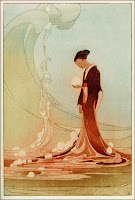hey guys. it’s certainly been a while. i’ve been thinking about a weird fantasy florida, recently, out in the palm scrub, where everything is mean and sharp and unfriendly and unnavigable and really kind of beautiful in a careless sort of way.
sinner
her flesh moves like fire on her bones, her hair roils like a plume of smoke from her head, her feet barely touch the water as she strides across it and you smell the black magic in the air: hot metal and raw meat and ozone.
- Each sinner knows a random cleric spell with a level equal to their HD. They can cast it at will.
- Sinners cannot cross lines of salt or enter holy ground or consecrated buildings like churches, and they must flee the sounds of church bells and calls to prayer as if they had failed a Morale check.
- Sinners can walk on water, walls, and ceilings; they are supernaturally light when it suits them, and any surface or structure that can support the weight of a crow will also support a sinner.
corpse
they are pale, luxuriously dressed in black veils and black lace, they move in groups of two or three, they dart about close to the ground in the edges of your vision. they never seem to be what they should, seeming to be very large and very far away, or else very small and very close; you always have to reach farther than you think to strike them with your weapon, but they can just raise their hand and touch you all the same.
- Each corpse can cast a random magic-user spell with a level equal to their HD. They can cast it at will.
- If a corpse sees an open grave (dug for the purposes of burying someone, at least 6 feet deep, a burial marker at the head of the grave), it must climb inside and lie down. If it hears properly recited funeral rites (INT check and a round of effort), it must make a Morale check. Corpses cannot cross lines of salt.
- As long as nobody can see its point of departure or arrival, a corpse can teleport to any location in 120′.
palm devil
a figure standing at the edge of the pines, a little too tall to be human, the contours of its body beneath its ragged coat too long and slender, it’s holding a palmetto frond in front of its face, and when it turns to you, all the leaves on all the trees as far as you can see rattle, malicious and filled with volition
- a palm devil’s face is indescribable; should anyone see it they must Save vs Magic or become Feebleminded. They will transform into a sinner by midnight of the following Sunday unless restored by Remove Curse.
- Can cast Gust of Wind, Move Earth, and Plant Growth twice each per fight.
- Can fly by riding its palm frond.
- In a palm devil’s hands, a palm frond functions as a vorpal axe and can easily cut through any mundane substance.
venomous augury
someone has nailed a huge rattlesnake to the trunk of a dead pine tree at regular intervals, tied lengths of red silk to each nail head. it looks at you with wet human eyes and tells you something horrible.
- the venomous augury knows everything, probably. A player can ask it anything and it will give them the true answer. This can amount to a wish–ask it where the elixir of eternal life it, and it will tell you, whether or not there was an elixir before you asked. However, every answer introduces an evil equal in influence or power to the wealth or knowledge being sought. Ask “where is the woman who will save the world?” and the augury is liable to answer “in the house of the man who will one day destroy it”
- once someone has asked the augury a question, it forevermore appears to them as a stinking dead rattlesnake grotesquely nailed to a tree.
prophet of mud
a huge hairless face emerges from the muck in front of you. it does not bother to turn its head, but swivels its bulging yellow eyes towards you as it begins to hum a hymn
- the prophet of mud is a third level cleric and knows Bless, Command, and Augury and can cast spells from its head or its hands.
- the prophet can emerge from any body of mud. it can reach its hands up from any body of mud or murky water that is contiguous with the mud it head is in.
- the prophet’s head and two hands get their own turn in the initiative order. it can only see what its head sees, naturally, but will feel things out with one hand to help the other.
- the prophet can spend a round singing hymns to cast Rock To Mud at will.
mother
there is a mother deep beneath the earth, she once had a shell of many hard plates and swam with many sharp legs and saw with a constellation of many watchful eyes. she died long ago, when this land was still a sea, but she is still here, she is a hollow in the bedrock far below, a long spiral in the dark. sometimes she tells the land what it used to be, and when she does it listens.
photos by me


















